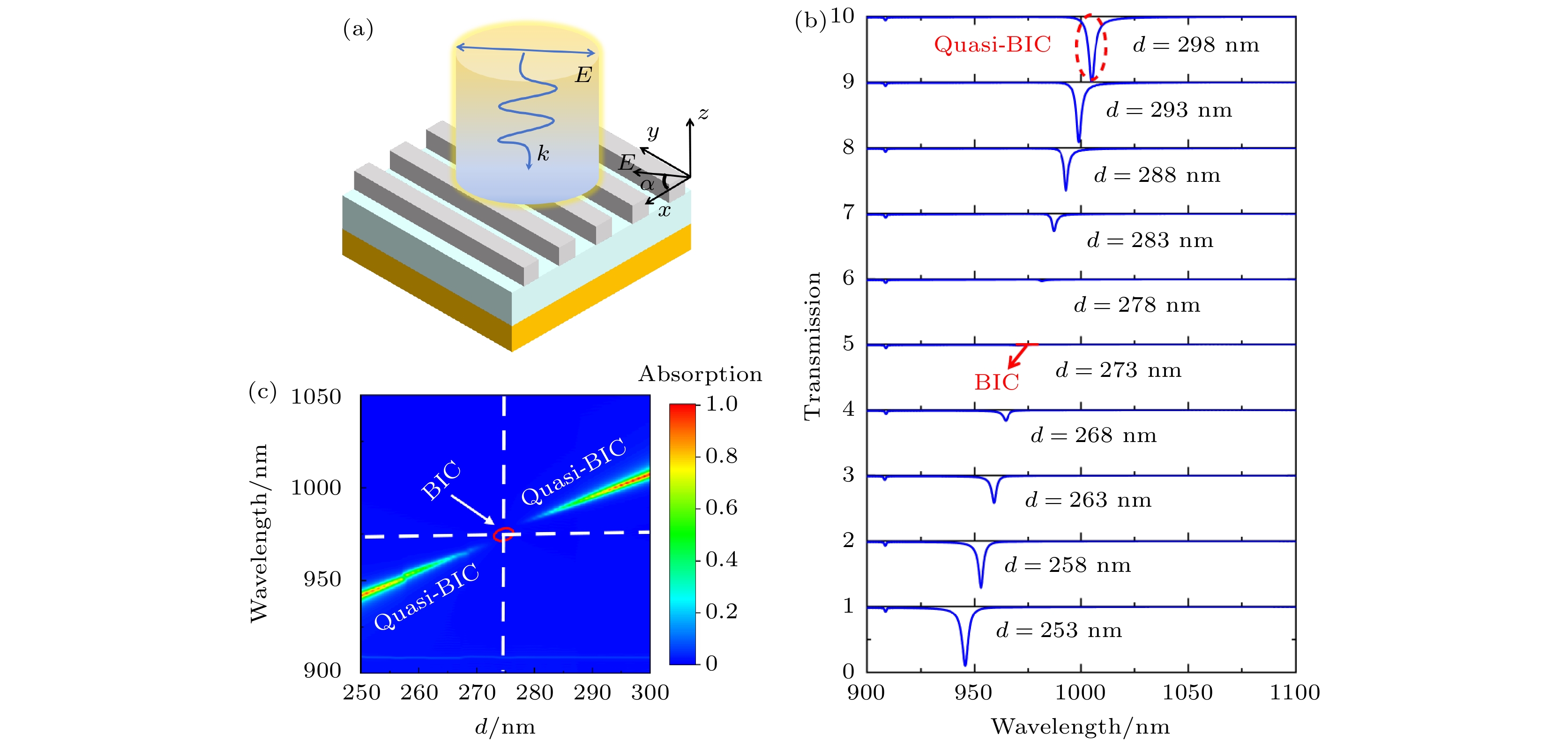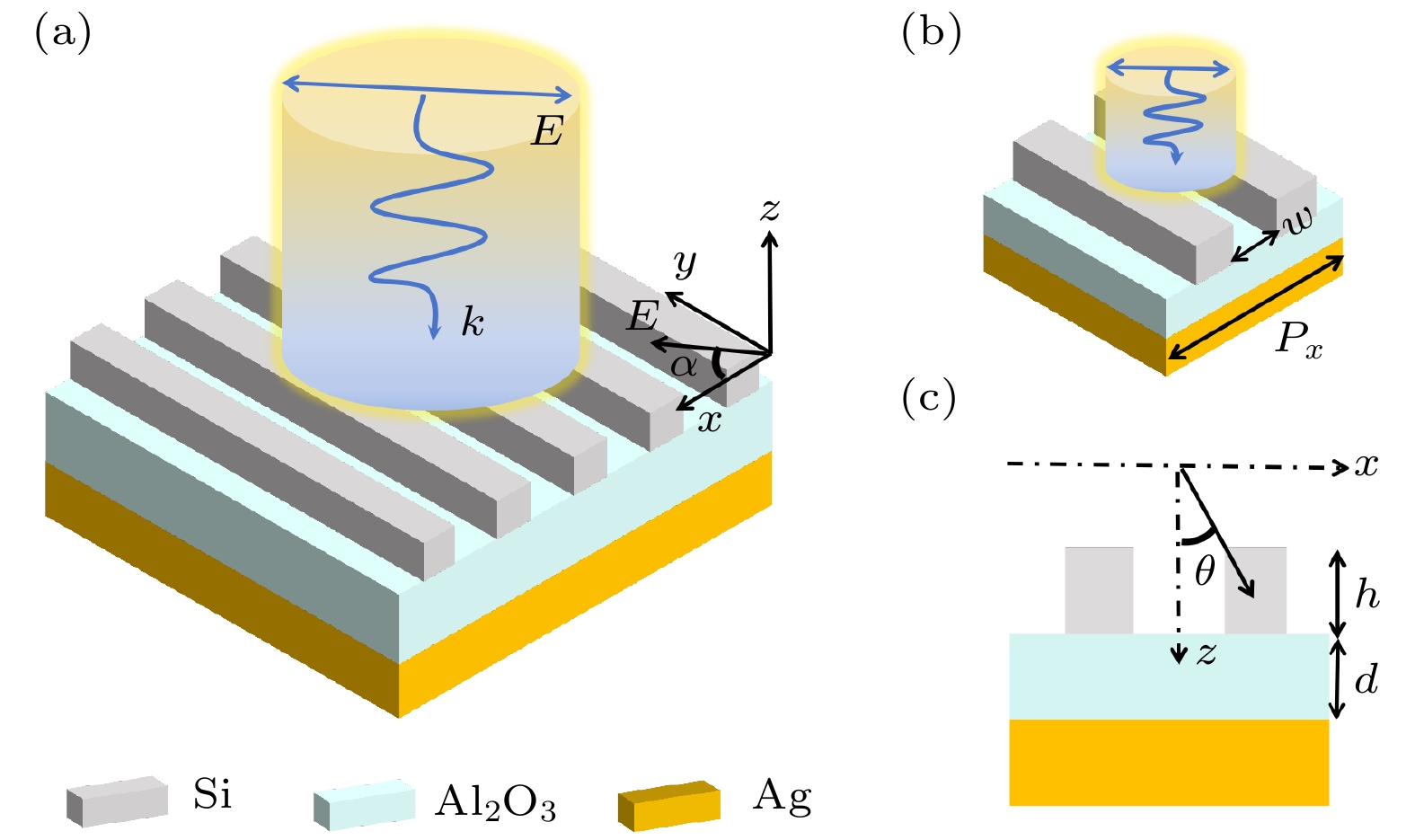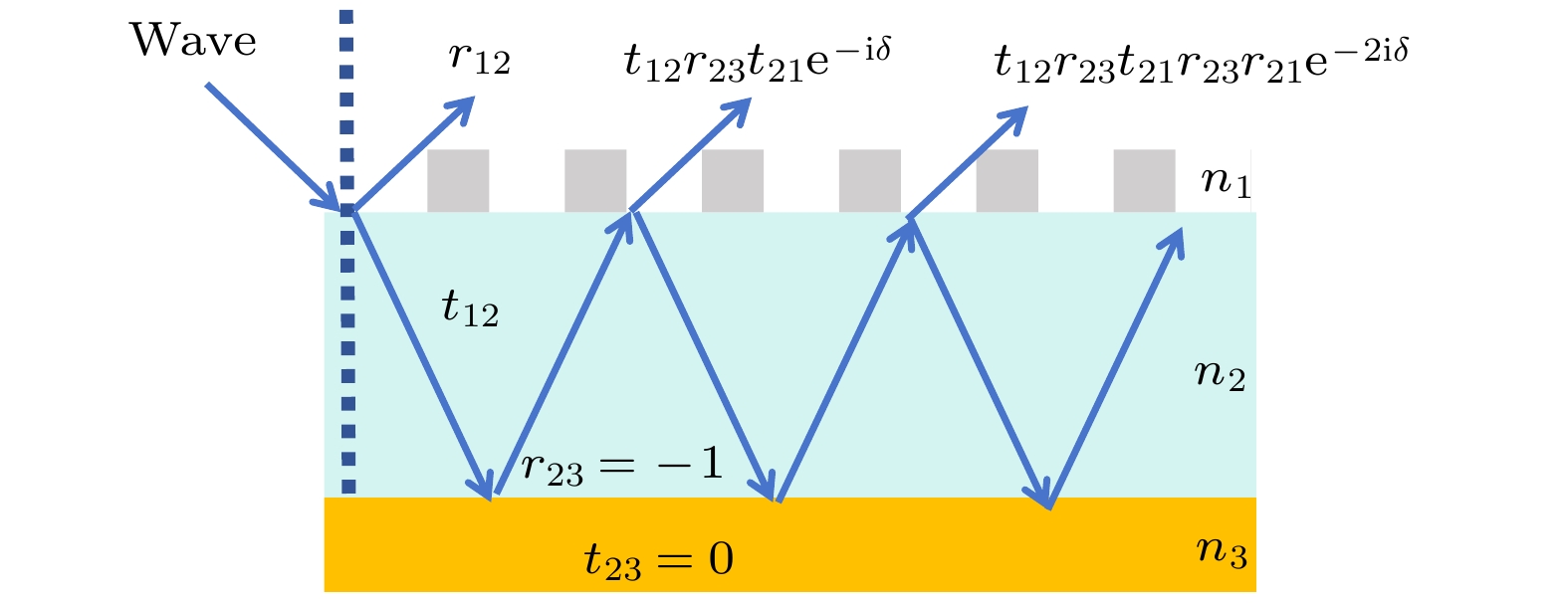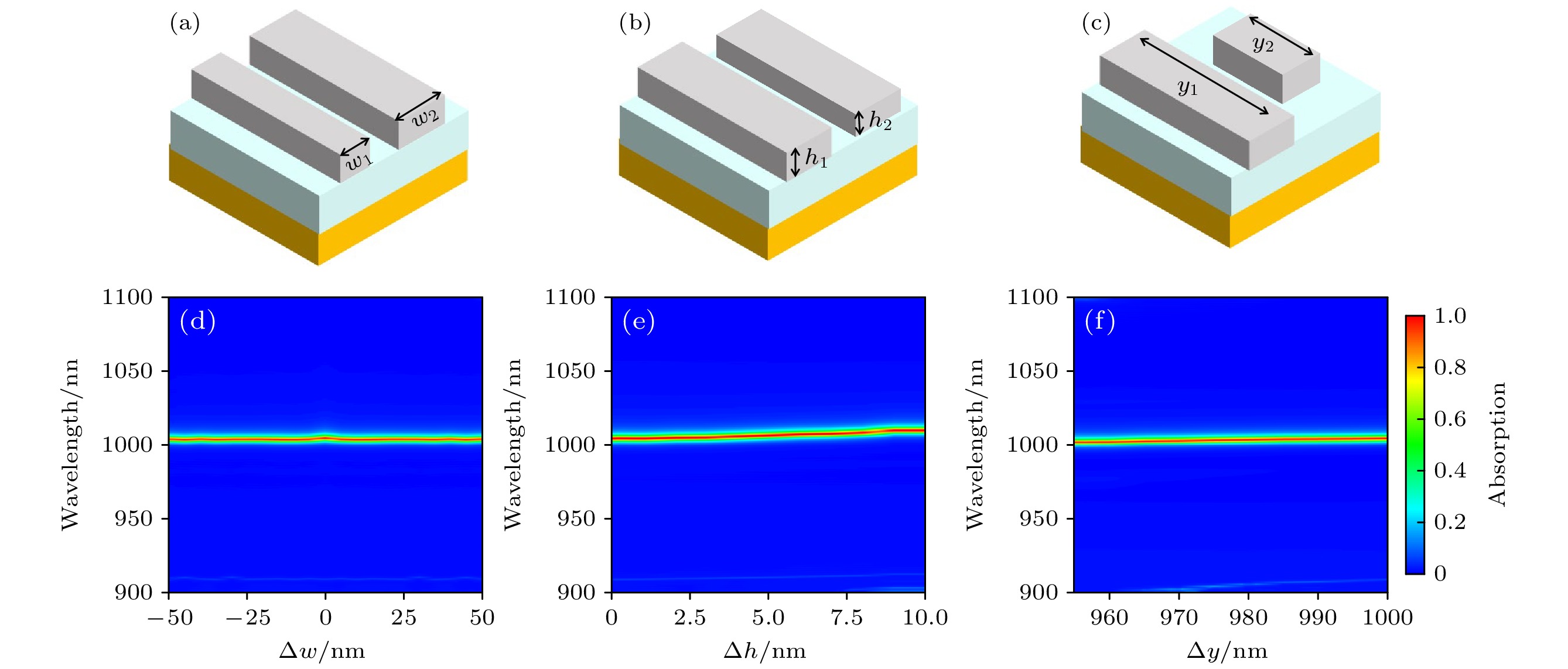-
优异的光学吸收器一直具备着高品质因数和完美吸收的特性, 然而, 这类吸收器通常会受到传统表面等离子体共振带来的欧姆损耗, 制约其在实际应用中的吸收性能. 本文提出了一种基于法布里-珀罗腔的可调谐连续域束缚态(bound state in the continuum, BIC), 通过调整模型的参数, 可将BIC可以转变为准BIC, 在连续谱中实现了100%的完美吸收. 在本文中, 采用干涉理论探究了影响完美吸收的因素, 用耦合模理论和阻抗匹配理论对准BIC进行理论计算, 采用电场和磁场理论解释了吸收器完美吸收的物理机制. 与传统吸收器相比, 该吸收器具有优异的结构参数鲁棒性和广泛的BIC调控范围. 更重要的是, 该吸收器具有出色的传感性能, 其最大灵敏度可达34 nm/RIU, 最大品质因数为9.5. 最后, 该吸收器还实现了双频的开光性能, 其中双频开关的最大调制深度和最小插入损耗分别为99.4%和0.0004 dB. 这些研究结果在光子学、光通信、传感器技术等领域具有重要意义.Excellent optical absorbers are always characterized by high quality factors and perfect absorption; however, these absorbers usually encounter the ohmic losses due to traditional surface plasmon resonance, which limits their absorption performance in practical applications. To address the problem, a tunable bound state in the continuum (BIC) based on Fabry-Perot cavity is proposed in this work. Figure (a) shows the structural model of the designed Fabry-Perot cavity absorber, which consists of Ag as a substrate, a layer of the dielectric material Al2O3 above the Ag substrate, and a high-refractive-index grating as the top dielectric layer Si ridge. By adjusting the thickness parameter d of Al2O3, the transformation of BIC into q-BIC is achieved. Specifically, when d is increased from 273 nm to 298 nm, the BIC can be transformed into quasi-BIC, and the perfect absorption of the absorber in the continuum spectrum can be increased to 100%. In this work, the factors affecting the perfect absorption are explored by using the interference theory; theoretical calculations of the quasi-BIC are carried out by using the coupled mode theory and impedance matching theory; the physical mechanism of the BIC is explained by using the electric and magnetic field theory. The BIC is caused by the electric and magnetic dipole modes as well as the mirror image of the base Ag, which causes the interferential phase cancellation effect. Compared with the conventional absorber, the proposed absorber has excellent structural parameter robustness and a wide range of BIC modulation. More importantly, the absorber has excellent sensing performance with a maximum sensitivity of up to 34 nm/RIU and a maximum quality factor of 9.5. Last but not least, the absorber also achieves dual-frequency open-light performance, the maximum modulation depth and the minimum insertion loss of the dual-frequency switch reach 99.4% and 0.0004 dB, respectively. These findings have significant implications in the fields of photonics, optical communication, and sensor technology.
-
Keywords:
- bound state in continuum /
- perfect absorption /
- coupled-mode theory /
- sensing
[1] Ali A, Mitra A, Aïssa B 2022 Nanomaterials 12 1027
 Google Scholar
Google Scholar
[2] Chen Y, Ai B, Wong Z J 2020 Nano Converg. 7 18
 Google Scholar
Google Scholar
[3] Martinez F, Maldovan M 2022 Mater. Today Phys. 27 100819
 Google Scholar
Google Scholar
[4] Padilla W J, Fan K 2022 Metamaterial Eectromagnetic Wave Absorbers (Springer Nature) p12
[5] Nie G, Shi Q, Zhu Z, Shi J 2014 Appl. Phys. Lett. 105 201909
 Google Scholar
Google Scholar
[6] Luo X, Liu Z, Wang L, Liu J, Lin Q 2018 Appl. Phys. Express 11 105102
 Google Scholar
Google Scholar
[7] Lavchiev V M, Jakoby B, Hedenig U, Grille T, Irsigler P, Ritchie G, Kirkbride J, Lendl B SENSORS 2014 IEEE, Valencia, November 2–5, 2014 p645
[8] Ren Y, Cui W, Yang Z, Xiong B, Zhang L, Li Z, Lu S, Huo Y, Wu X, Li G 2024 Opt. Mater. 149 115073
 Google Scholar
Google Scholar
[9] Jiang H, Sabarinathan J, Manifar T, Mittler S 2009 J. Lightwave Technol. 27 2264
 Google Scholar
Google Scholar
[10] Tarumaraja K A, Menon P S, Said F A, Jamil N A, Ehsan A A, Shaari S, Majlis B Y, Jalar A 2016 IEEE International Conference on Semiconductor Electronicsp, Kuala Lumpur Malaysia, August 17–19, 2016 p79
[11] Lin H, Lin K T, Yang T, Jia B 2021 Adv. Mater. Technol. 6 2000963
 Google Scholar
Google Scholar
[12] Boardman A D, Grimalsky V V, Kivshar Y S, Koshevaya S V, Lapine M, Litchinitser N M, Malnev V N, Noginov M, Rapoport Y G, Shalaev V M 2011 Laser Photonics Rev. 5 287
 Google Scholar
Google Scholar
[13] Kowerdziej R, Ferraro A, Zografopoulos D C, Caputo R 2022 Adv. Opt. Mater. 10 2200750
 Google Scholar
Google Scholar
[14] Jin R, Huang L J, Zhou C B, Guo J, Fu Z, Chen J, Wang J, Li X, Yu F, Chen J 2023 Nano Lett. 23 9105
 Google Scholar
Google Scholar
[15] Zhou C B, Huang L J, Jin R, Xu L, Li G H, Rahmani M, Chen X S, Lu W, Miroshnichenko A E 2023 Laser Photonics Rev. 17 2200564
 Google Scholar
Google Scholar
[16] Koshelev K, Bogdanov A, Kivshar Y 2019 Sci. Bull. 64 836
 Google Scholar
Google Scholar
[17] Masoudian Saadabad R, Huang L J, Miroshnichenko A E 2021 Phys. Rev. B 104 235405
 Google Scholar
Google Scholar
[18] Yuan L, Lu Y Y 2017 Opt. Lett. 42 4490
 Google Scholar
Google Scholar
[19] Jordan P, Von Neumann J, Wigner E P 1993 The Collected Works of Eugene Paul Wigner: Part A: The Scientific Papers (Springer Berlin Heidelberg) p298
[20] Xie P, Liang Z C, Jia T T, Li D M, Chen Y X, Chang P J, Zhang H, Wang W 2021 Phys. Rev. B 104 125446
 Google Scholar
Google Scholar
[21] Huang L J, Jin R, Zhou C B, Li G H, Xu L, Overvig A, Deng F, Chen X H, Lu W, Alù A, Miroshnichenko A E 2023 Nat. Commun. 14 3433
 Google Scholar
Google Scholar
[22] Wan S, Qin C H, Wang K D, Li Y C, Guan C Y, Lv B, Li W J, Shi J H 2022 J. Appl. Phys. 131 213104
 Google Scholar
Google Scholar
[23] Wu F, Qi X, Qin M B, Luo M, Long Y, Wu J J, Sun Y, Jiang H T, Liu T T, Xiao S Y, Chen H 2024 Phys. Rev. B 109 085436
 Google Scholar
Google Scholar
[24] Wu F, Wu J J, Guo Z W, Jiang H T, Sun Y, Li Y H, Ren J, Chen H 2019 Phys. Rev. Appl. 12 014028
 Google Scholar
Google Scholar
[25] Gao E D, Li H J, Liu C, Ruan B X, Li M, Zhang B H, Zhang Z 2022 Phys. Chem. Chem. Phys. 24 20125
 Google Scholar
Google Scholar
[26] Moriasa K, Hasebe H, Sugimoto H, Fujii M 2023 J. Appl. Phys. 133 173102
 Google Scholar
Google Scholar
[27] Wang Y X, Cui W, Ren Y, Li Z X, Zhang L, Lei W L, Huo Y S, He Z H 2024 Infrared Phys. Technol. 136 105091
 Google Scholar
Google Scholar
[28] Ki Y G, Jeon H W, Kim S J 2024 Electronics 13 753
 Google Scholar
Google Scholar
[29] Johnson P B, Christy R W 1972 Phys. Rev. B 6 4370
 Google Scholar
Google Scholar
[30] Schinke C, Christian Peest P, Schmidt J, Brendel R, Bothe K, Vogt M R, Kröger I, Winter S, Schirmacher A, Lim S 2015 Aip Adv. 5 067168
 Google Scholar
Google Scholar
[31] Malitson I H, Dodge M J 1972 J. Opt. Soc. Am 62 1405
[32] Alaee R, Farhat M, Rockstuhl C, Lederer F 2012 Opt. Express 20 28017
 Google Scholar
Google Scholar
[33] Xie Y D, Liu Z M, Zhou F Q, Luo X, Cheng Z Q, Yang R H, Cheng J, Yang G X 2023 Diamond Relat. Mater. 137 110100
 Google Scholar
Google Scholar
[34] Qing Y M, Ma H F, Cui T J 2018 Opt. Express 26 32442
 Google Scholar
Google Scholar
[35] Li H J, Wang L L, Zhai X 2016 Sci. Rep. 6 36651
 Google Scholar
Google Scholar
[36] Smith D, Vier D, Koschny T, Soukoulis C 2005 Phys. Rev. E 71 036617
 Google Scholar
Google Scholar
[37] Wang Y X, Cui W, Wang X J, Lei W L, Li L Q, Cao X L, He H, He Z H 2022 Vacuum 206 111515
 Google Scholar
Google Scholar
[38] Gao E D, Cao G T, Deng Y, Li H J, Chen X S, Li G H 2024 Opt. Laser Technol. 168 109840
 Google Scholar
Google Scholar
[39] Li M, Li H J, Xu H, Xiong C X, Zhao M Z, Liu C, Ruan B X, Zhang B H, Wu K 2020 New J. Phys. 22 103030
 Google Scholar
Google Scholar
[40] Kim M, Kim S, Kim S 2022 Sci. Rep. 12 1445
 Google Scholar
Google Scholar
[41] Gao E D, Jin R, Fu Z C, Cao G T, Deng Y, Chen J, Li G H, Chen X S, Li H J 2023 Photonics Res. 11 456
 Google Scholar
Google Scholar
-
图 3 (a) Si/Al2O3/Ag超材料吸收器的吸收光谱和透射光谱; (b)参数d变化对吸收光谱的影响; (c) BIC和q-BIC与参数d的关系; (d) BIC的磁场分布; (e)BIC的电场分布
Fig. 3. (a) Absorption and transmission spectra of Si/Al2O3/Ag metamaterial absorber; (b) effect of parameter d variation on the absorption spectra; (c) BIC and q-BIC versus parameter d; (d) magnetic field distribution of BIC; (e) electric field distribution of BIC.
图 8 (a)吸收器Δw的单元结构图; (b)吸收器Δh的单元结构图; (c)吸收器Δy的单元结构图; (d)参数Δw随波长变化的吸收光谱; (e)参数Δh随波长变化的吸收光谱; (f)参数Δy随波长变化的吸收光谱
Fig. 8. (a) Unit structure diagram of absorber Δw; (b) unit structure diagram of absorber Δh; (c) unit structure diagram of absorber Δy; (d) absorption spectra of parameter Δw varying with wavelength; (e) absorption spectra of parameter Δh as a function of wavelength; (f) absorption spectra of parameter Δy as a function of wavelength.
图 9 w = 155 nm时, (a)光源偏振角α和(b)光源入射角θ对BIC的影响; 分别是w = 140 nm时, (c)光源偏振角α和(d)光源入射角θ对BIC的影响
Fig. 9. Effects of (a) the light source polarization angle α and (b) incidence angle θ on the BIC at w = 155 nm, respectively; effects of (c) the light source polarization angle α and (d) incidence angle θ on the BIC at w = 140 nm, respectively.
图 10 (a)不同折射率下吸收器的吸收光谱; (b)不同折射率下吸收峰值和波长的变化; (c)不同折射率下半峰宽度和Q的变化; (d)不同折射率下灵敏度和品质因数的变化
Fig. 10. (a) Absorption spectra of the absorber at different refractive indices; (b) variation of absorption peak and wavelength at different refractive indices; (c) variation of full width half maximum and Q at different refractive indices; (d) variation of sensitivity and figure of merit at different refractive indices.
表 1 本文吸收器的特性与文献进行比较
Table 1. Characterization of the absorber in this paper is compared with other published references.
-
[1] Ali A, Mitra A, Aïssa B 2022 Nanomaterials 12 1027
 Google Scholar
Google Scholar
[2] Chen Y, Ai B, Wong Z J 2020 Nano Converg. 7 18
 Google Scholar
Google Scholar
[3] Martinez F, Maldovan M 2022 Mater. Today Phys. 27 100819
 Google Scholar
Google Scholar
[4] Padilla W J, Fan K 2022 Metamaterial Eectromagnetic Wave Absorbers (Springer Nature) p12
[5] Nie G, Shi Q, Zhu Z, Shi J 2014 Appl. Phys. Lett. 105 201909
 Google Scholar
Google Scholar
[6] Luo X, Liu Z, Wang L, Liu J, Lin Q 2018 Appl. Phys. Express 11 105102
 Google Scholar
Google Scholar
[7] Lavchiev V M, Jakoby B, Hedenig U, Grille T, Irsigler P, Ritchie G, Kirkbride J, Lendl B SENSORS 2014 IEEE, Valencia, November 2–5, 2014 p645
[8] Ren Y, Cui W, Yang Z, Xiong B, Zhang L, Li Z, Lu S, Huo Y, Wu X, Li G 2024 Opt. Mater. 149 115073
 Google Scholar
Google Scholar
[9] Jiang H, Sabarinathan J, Manifar T, Mittler S 2009 J. Lightwave Technol. 27 2264
 Google Scholar
Google Scholar
[10] Tarumaraja K A, Menon P S, Said F A, Jamil N A, Ehsan A A, Shaari S, Majlis B Y, Jalar A 2016 IEEE International Conference on Semiconductor Electronicsp, Kuala Lumpur Malaysia, August 17–19, 2016 p79
[11] Lin H, Lin K T, Yang T, Jia B 2021 Adv. Mater. Technol. 6 2000963
 Google Scholar
Google Scholar
[12] Boardman A D, Grimalsky V V, Kivshar Y S, Koshevaya S V, Lapine M, Litchinitser N M, Malnev V N, Noginov M, Rapoport Y G, Shalaev V M 2011 Laser Photonics Rev. 5 287
 Google Scholar
Google Scholar
[13] Kowerdziej R, Ferraro A, Zografopoulos D C, Caputo R 2022 Adv. Opt. Mater. 10 2200750
 Google Scholar
Google Scholar
[14] Jin R, Huang L J, Zhou C B, Guo J, Fu Z, Chen J, Wang J, Li X, Yu F, Chen J 2023 Nano Lett. 23 9105
 Google Scholar
Google Scholar
[15] Zhou C B, Huang L J, Jin R, Xu L, Li G H, Rahmani M, Chen X S, Lu W, Miroshnichenko A E 2023 Laser Photonics Rev. 17 2200564
 Google Scholar
Google Scholar
[16] Koshelev K, Bogdanov A, Kivshar Y 2019 Sci. Bull. 64 836
 Google Scholar
Google Scholar
[17] Masoudian Saadabad R, Huang L J, Miroshnichenko A E 2021 Phys. Rev. B 104 235405
 Google Scholar
Google Scholar
[18] Yuan L, Lu Y Y 2017 Opt. Lett. 42 4490
 Google Scholar
Google Scholar
[19] Jordan P, Von Neumann J, Wigner E P 1993 The Collected Works of Eugene Paul Wigner: Part A: The Scientific Papers (Springer Berlin Heidelberg) p298
[20] Xie P, Liang Z C, Jia T T, Li D M, Chen Y X, Chang P J, Zhang H, Wang W 2021 Phys. Rev. B 104 125446
 Google Scholar
Google Scholar
[21] Huang L J, Jin R, Zhou C B, Li G H, Xu L, Overvig A, Deng F, Chen X H, Lu W, Alù A, Miroshnichenko A E 2023 Nat. Commun. 14 3433
 Google Scholar
Google Scholar
[22] Wan S, Qin C H, Wang K D, Li Y C, Guan C Y, Lv B, Li W J, Shi J H 2022 J. Appl. Phys. 131 213104
 Google Scholar
Google Scholar
[23] Wu F, Qi X, Qin M B, Luo M, Long Y, Wu J J, Sun Y, Jiang H T, Liu T T, Xiao S Y, Chen H 2024 Phys. Rev. B 109 085436
 Google Scholar
Google Scholar
[24] Wu F, Wu J J, Guo Z W, Jiang H T, Sun Y, Li Y H, Ren J, Chen H 2019 Phys. Rev. Appl. 12 014028
 Google Scholar
Google Scholar
[25] Gao E D, Li H J, Liu C, Ruan B X, Li M, Zhang B H, Zhang Z 2022 Phys. Chem. Chem. Phys. 24 20125
 Google Scholar
Google Scholar
[26] Moriasa K, Hasebe H, Sugimoto H, Fujii M 2023 J. Appl. Phys. 133 173102
 Google Scholar
Google Scholar
[27] Wang Y X, Cui W, Ren Y, Li Z X, Zhang L, Lei W L, Huo Y S, He Z H 2024 Infrared Phys. Technol. 136 105091
 Google Scholar
Google Scholar
[28] Ki Y G, Jeon H W, Kim S J 2024 Electronics 13 753
 Google Scholar
Google Scholar
[29] Johnson P B, Christy R W 1972 Phys. Rev. B 6 4370
 Google Scholar
Google Scholar
[30] Schinke C, Christian Peest P, Schmidt J, Brendel R, Bothe K, Vogt M R, Kröger I, Winter S, Schirmacher A, Lim S 2015 Aip Adv. 5 067168
 Google Scholar
Google Scholar
[31] Malitson I H, Dodge M J 1972 J. Opt. Soc. Am 62 1405
[32] Alaee R, Farhat M, Rockstuhl C, Lederer F 2012 Opt. Express 20 28017
 Google Scholar
Google Scholar
[33] Xie Y D, Liu Z M, Zhou F Q, Luo X, Cheng Z Q, Yang R H, Cheng J, Yang G X 2023 Diamond Relat. Mater. 137 110100
 Google Scholar
Google Scholar
[34] Qing Y M, Ma H F, Cui T J 2018 Opt. Express 26 32442
 Google Scholar
Google Scholar
[35] Li H J, Wang L L, Zhai X 2016 Sci. Rep. 6 36651
 Google Scholar
Google Scholar
[36] Smith D, Vier D, Koschny T, Soukoulis C 2005 Phys. Rev. E 71 036617
 Google Scholar
Google Scholar
[37] Wang Y X, Cui W, Wang X J, Lei W L, Li L Q, Cao X L, He H, He Z H 2022 Vacuum 206 111515
 Google Scholar
Google Scholar
[38] Gao E D, Cao G T, Deng Y, Li H J, Chen X S, Li G H 2024 Opt. Laser Technol. 168 109840
 Google Scholar
Google Scholar
[39] Li M, Li H J, Xu H, Xiong C X, Zhao M Z, Liu C, Ruan B X, Zhang B H, Wu K 2020 New J. Phys. 22 103030
 Google Scholar
Google Scholar
[40] Kim M, Kim S, Kim S 2022 Sci. Rep. 12 1445
 Google Scholar
Google Scholar
[41] Gao E D, Jin R, Fu Z C, Cao G T, Deng Y, Chen J, Li G H, Chen X S, Li H J 2023 Photonics Res. 11 456
 Google Scholar
Google Scholar
计量
- 文章访问数: 931
- PDF下载量: 46
- 被引次数: 0















 下载:
下载:










